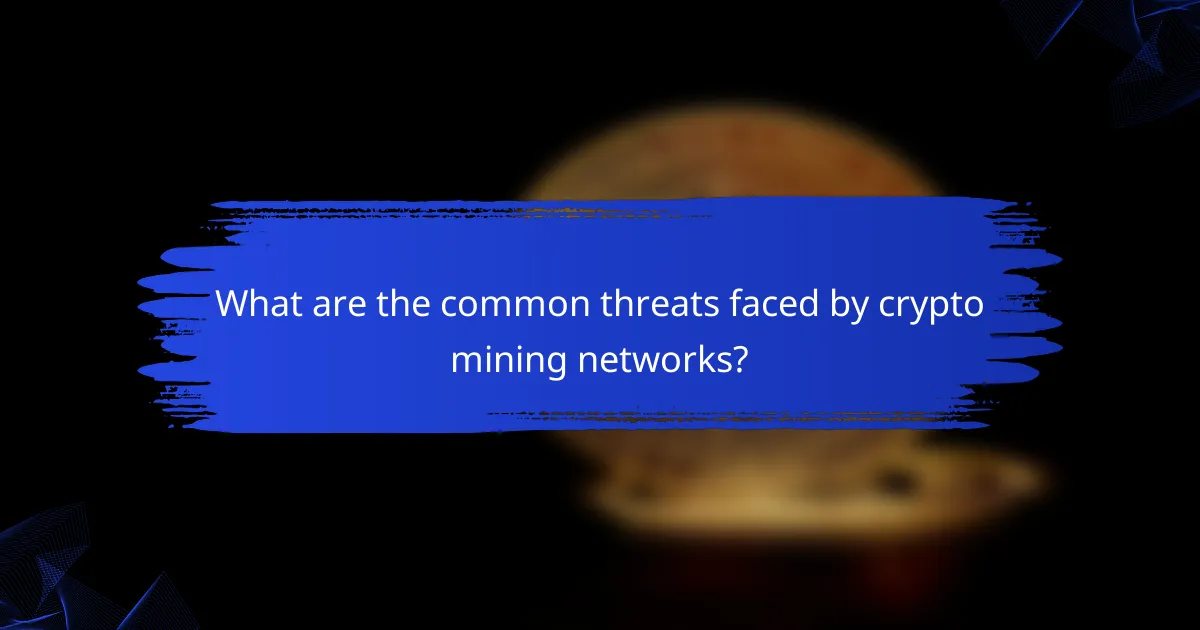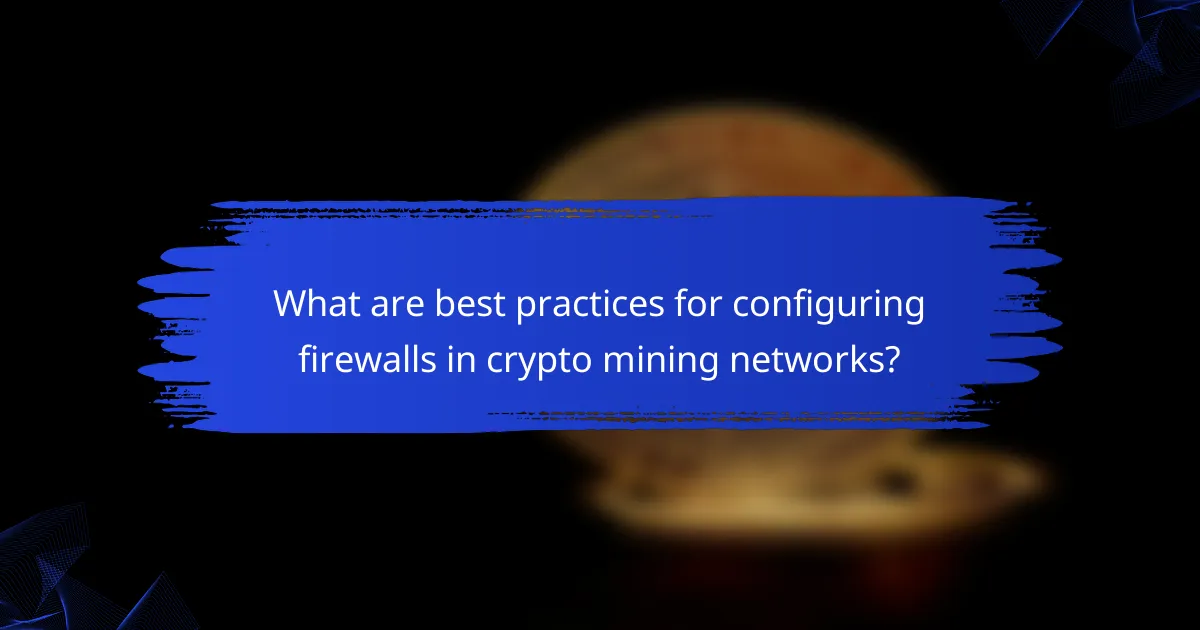Firewalls are essential security tools designed to protect crypto mining networks from external threats. They function by monitoring and filtering incoming and outgoing traffic based on predefined security rules, thereby preventing unauthorized access and potential attacks such as Distributed Denial of Service (DDoS) and malware infiltration. The article highlights the increasing risks of cybercrime, projected to cost $10.5 trillion annually by 2025, and emphasizes the necessity of robust firewall protection to safeguard mining operations. Key security measures, including access control lists (ACLs), regular updates of firewall rules, and network segmentation, are discussed to enhance the integrity and security of crypto mining networks.

What is the Role of Firewalls in Protecting Crypto Mining Networks?
Firewalls play a critical role in protecting crypto mining networks. They act as a barrier between the internal network and external threats. Firewalls monitor incoming and outgoing traffic. They filter data packets based on security rules. This helps prevent unauthorized access to mining operations. Additionally, firewalls can block malicious traffic and attacks. They also help maintain the integrity of mining software. According to a report by Cybersecurity Ventures, cybercrime is projected to cost the world $10.5 trillion annually by 2025. This highlights the importance of robust firewall protection in crypto mining.
How do firewalls function within crypto mining networks?
Firewalls function within crypto mining networks by monitoring and controlling incoming and outgoing network traffic. They establish a barrier between trusted internal networks and untrusted external networks. Firewalls can block unauthorized access to mining rigs and protect sensitive data. They enforce security policies by allowing or denying traffic based on predefined rules. This helps mitigate risks such as hacking attempts and DDoS attacks. Firewalls also log traffic data for analysis, aiding in threat detection and response. Their implementation is crucial for maintaining the integrity and security of mining operations.
What types of firewalls are commonly used in crypto mining?
The types of firewalls commonly used in crypto mining include hardware firewalls, software firewalls, and next-generation firewalls. Hardware firewalls are physical devices that protect the network perimeter. They offer robust security features and can handle large amounts of traffic. Software firewalls are applications installed on individual devices. They provide customizable security settings and can monitor incoming and outgoing traffic. Next-generation firewalls combine traditional firewall capabilities with advanced features like intrusion prevention and application awareness. These firewalls enhance security by analyzing traffic patterns and blocking malicious activities. Each type plays a vital role in safeguarding crypto mining operations from cyber threats.
How do firewalls differentiate between legitimate and malicious traffic?
Firewalls differentiate between legitimate and malicious traffic using predefined rules and algorithms. They analyze incoming and outgoing data packets based on attributes such as source IP address, destination IP address, and port numbers. Firewalls employ techniques like packet filtering, stateful inspection, and deep packet inspection. Packet filtering examines header information to allow or block traffic. Stateful inspection tracks active connections and determines if packets are part of an established session. Deep packet inspection inspects the content of packets for known threats or anomalies. These methods help firewalls identify patterns consistent with malicious activity. According to a study by the SANS Institute, effective firewall rules can reduce unauthorized access attempts by over 90%.
What are the key benefits of using firewalls in crypto mining?
Firewalls provide essential security benefits in crypto mining. They protect mining networks from unauthorized access and cyberattacks. By filtering incoming and outgoing traffic, firewalls block malicious attempts to infiltrate systems. This reduces the risk of data breaches and loss of sensitive information. Firewalls can also prevent Distributed Denial of Service (DDoS) attacks, which can disrupt mining operations. Additionally, they allow for monitoring of network activity, helping to identify suspicious behavior. Overall, firewalls enhance the overall security posture of crypto mining operations.
How do firewalls enhance the security of mining operations?
Firewalls enhance the security of mining operations by controlling incoming and outgoing network traffic. They act as a barrier between trusted internal networks and untrusted external networks. Firewalls monitor data packets and determine whether to allow or block them based on predefined security rules. This helps prevent unauthorized access to mining systems. Additionally, firewalls can detect and mitigate potential threats in real-time. For example, they can block malicious IP addresses that attempt to exploit vulnerabilities. By filtering traffic, firewalls reduce the risk of data breaches and cyberattacks. Overall, firewalls are essential for maintaining the integrity and security of mining operations.
What impact do firewalls have on network performance?
Firewalls can impact network performance by introducing latency and reducing throughput. The process of inspecting and filtering traffic requires computational resources. This can lead to slower data transmission speeds. For instance, a firewall may drop packets or delay them for inspection. Such actions can affect applications that require real-time data transfer. According to a study by IDC, network performance can decrease by up to 30% when using improperly configured firewalls. Therefore, while firewalls enhance security, they can also create bottlenecks in network performance.

What are the common threats faced by crypto mining networks?
Common threats faced by crypto mining networks include Distributed Denial of Service (DDoS) attacks, malware, and hacking attempts. DDoS attacks can overwhelm network resources, causing downtime. Malware can infiltrate mining software, leading to loss of assets. Hacking attempts target vulnerabilities in network security. According to a report by Cybersecurity Ventures, cybercrime damages are expected to reach $10.5 trillion annually by 2025, highlighting the severity of these threats. Additionally, the rise of cryptojacking, where unauthorized users hijack computing power, poses significant risks to mining operations. These threats necessitate robust security measures, such as firewalls, to protect against potential breaches.
How do cyberattacks specifically target crypto mining operations?
Cyberattacks specifically target crypto mining operations through various methods, including Distributed Denial of Service (DDoS) attacks, malware, and phishing. DDoS attacks overwhelm mining servers, causing downtime and loss of revenue. Malware can infiltrate mining software, leading to unauthorized access and theft of cryptocurrency. Phishing attempts trick employees into revealing sensitive information, compromising security. According to a report by Cybersecurity Ventures, cybercrime costs the global economy over $6 trillion annually, highlighting the financial impact on crypto mining. These tactics exploit vulnerabilities in mining networks, making effective firewall protection essential.
What types of malware are prevalent in the crypto mining space?
Cryptojacking malware is prevalent in the crypto mining space. This type of malware hijacks a victim’s computer resources to mine cryptocurrencies without their consent. Ransomware is also common, locking users out of their systems until a ransom is paid. Trojan malware can disguise itself as legitimate software while facilitating unauthorized crypto mining. Additionally, mining bots can infect systems to create botnets for large-scale mining operations. According to a report by McAfee, cryptojacking incidents increased by 629% in 2018, highlighting the growing threat. These malware types exploit vulnerabilities in software and networks specifically targeting crypto mining activities.
How can denial-of-service attacks affect mining networks?
Denial-of-service attacks can severely disrupt mining networks by overwhelming them with traffic. This influx of malicious requests can lead to network congestion. As a result, legitimate mining operations may experience delays or interruptions. Miners rely on stable connections to validate transactions and earn rewards. If a mining network is incapacitated, miners cannot effectively participate in the blockchain. Historical data shows that mining pools targeted by such attacks have reported significant drops in hash rates. For instance, a 2018 attack on a mining pool resulted in a 50% reduction in operational efficiency. Thus, denial-of-service attacks pose a significant threat to the stability and profitability of mining networks.
Why is it crucial to implement firewalls against these threats?
Implementing firewalls is crucial to protect crypto mining networks from various threats. Firewalls serve as a barrier between trusted internal networks and untrusted external sources. They monitor incoming and outgoing traffic, blocking unauthorized access and potential attacks. Cyber threats like DDoS attacks can disrupt mining operations, leading to financial losses. According to a report by Cybersecurity Ventures, global cybercrime damages are projected to reach $10.5 trillion annually by 2025. Firewalls can prevent these threats by filtering malicious traffic and enforcing security policies. This proactive defense is essential for maintaining the integrity and availability of mining operations.
What vulnerabilities do firewalls address in mining networks?
Firewalls address several vulnerabilities in mining networks, including unauthorized access, malware infections, and data breaches. Unauthorized access can occur when attackers exploit weak security protocols. Firewalls create barriers that prevent unauthorized users from infiltrating the network. Malware infections can disrupt mining operations and compromise sensitive data. Firewalls filter out malicious traffic that could introduce harmful software. Data breaches pose significant risks, as they can lead to the theft of valuable information. Firewalls help protect against these breaches by monitoring and controlling incoming and outgoing network traffic. Overall, firewalls are essential for maintaining the integrity and security of mining networks.
How do firewalls help in compliance with regulatory standards?
Firewalls help in compliance with regulatory standards by controlling network traffic and protecting sensitive data. They enforce security policies that align with regulations such as GDPR and HIPAA. Firewalls monitor and filter incoming and outgoing traffic based on predetermined security rules. This capability reduces the risk of data breaches, which is a key compliance requirement. Additionally, they log and report network activities, providing necessary audit trails for regulatory assessments. By maintaining secure configurations, firewalls help organizations demonstrate adherence to industry standards. This proactive security measure is essential for avoiding penalties associated with non-compliance.

What are best practices for configuring firewalls in crypto mining networks?
Implement strong access control lists (ACLs) to restrict unauthorized access in crypto mining networks. This involves specifying which IP addresses can access the mining equipment. Regularly update firewall rules to adapt to new threats and vulnerabilities. Monitor network traffic for unusual patterns that may indicate a breach. Use intrusion detection systems (IDS) in conjunction with firewalls for enhanced security. Ensure that all firewall software is up to date to protect against known vulnerabilities. Implement logging and alerting to track access attempts and potential security incidents. Segment the network to isolate mining operations from other network components. This reduces the risk of lateral movement by attackers.
How should firewalls be set up to maximize protection?
Firewalls should be set up with strict rules and configurations to maximize protection. First, define the firewall’s role in monitoring and controlling incoming and outgoing network traffic. Configure inbound and outbound rules to allow only necessary traffic. This minimizes exposure to potential threats. Implement network segmentation to isolate critical systems. This limits lateral movement within the network. Regularly update firewall firmware and rulesets to protect against new vulnerabilities. Conduct periodic security audits to assess the effectiveness of firewall configurations. Utilize logging and monitoring tools to detect and respond to suspicious activities. These practices collectively enhance the firewall’s protective capabilities in crypto mining networks.
What rules and policies should be implemented in firewall settings?
Implementing rules and policies in firewall settings is crucial for securing crypto mining networks. Essential rules include allowing only necessary inbound and outbound traffic. Policies should restrict access to critical ports used by mining software. It is vital to block all unused ports to minimize vulnerabilities. Additionally, implementing IP whitelisting can prevent unauthorized access. Regularly updating firewall rules is important to adapt to new threats. Logging and monitoring traffic can help identify suspicious activities. Finally, using intrusion detection systems enhances overall network security.
How often should firewall configurations be reviewed and updated?
Firewall configurations should be reviewed and updated at least quarterly. Regular reviews help identify vulnerabilities and ensure compliance with security policies. Cyber threats evolve rapidly, making frequent updates essential. According to the National Institute of Standards and Technology (NIST), organizations should conduct reviews and updates based on changes in the network environment. This includes new devices, applications, or security incidents. In addition, immediate updates are recommended following any security breach. Following these guidelines enhances the overall security posture of the network.
What troubleshooting tips can help maintain firewall effectiveness?
Regularly update firewall firmware to address vulnerabilities. This practice ensures that the firewall has the latest security patches. Monitor firewall logs for unusual activity. This helps in identifying potential threats quickly. Configure alerts for specific events to enhance response time. Conduct periodic security audits to assess firewall rules and effectiveness. Test firewall rules to ensure they function as intended. Review and refine access control policies regularly to limit exposure. Ensure that all network devices are included in the firewall’s protection scope.
How can network monitoring tools assist in firewall management?
Network monitoring tools assist in firewall management by providing real-time visibility into network traffic. They enable administrators to detect anomalies and potential threats. These tools can analyze traffic patterns and identify unauthorized access attempts. Additionally, they help in optimizing firewall rules based on actual usage data. By monitoring logs, they can pinpoint misconfigurations or rule violations. This proactive approach enhances the overall security posture. Studies show that effective monitoring can reduce response times to incidents by up to 50%. Thus, integrating monitoring tools with firewalls strengthens the defense of crypto mining networks.
What steps should be taken if a firewall breach is detected?
Immediately isolate the affected system to prevent further damage. This limits the breach’s impact on the network. Next, analyze the breach to understand how it occurred. Review logs and alerts to gather information on the attack vector. Update firewall rules to block the identified threat. This prevents similar breaches in the future. Notify relevant stakeholders about the breach and its potential impact. Document all findings and actions taken for future reference. Finally, conduct a thorough security assessment to identify vulnerabilities. Implement additional security measures based on the assessment results.
The main entity of this article is firewalls and their role in protecting crypto mining networks. Firewalls serve as a critical defense mechanism by monitoring and controlling network traffic, preventing unauthorized access, and mitigating cyber threats such as DDoS attacks and malware. The article discusses various types of firewalls, their functionality, benefits, and how they differentiate between legitimate and malicious traffic. Additionally, it addresses common threats faced by crypto mining networks and outlines best practices for configuring firewalls to enhance security and compliance with regulatory standards.